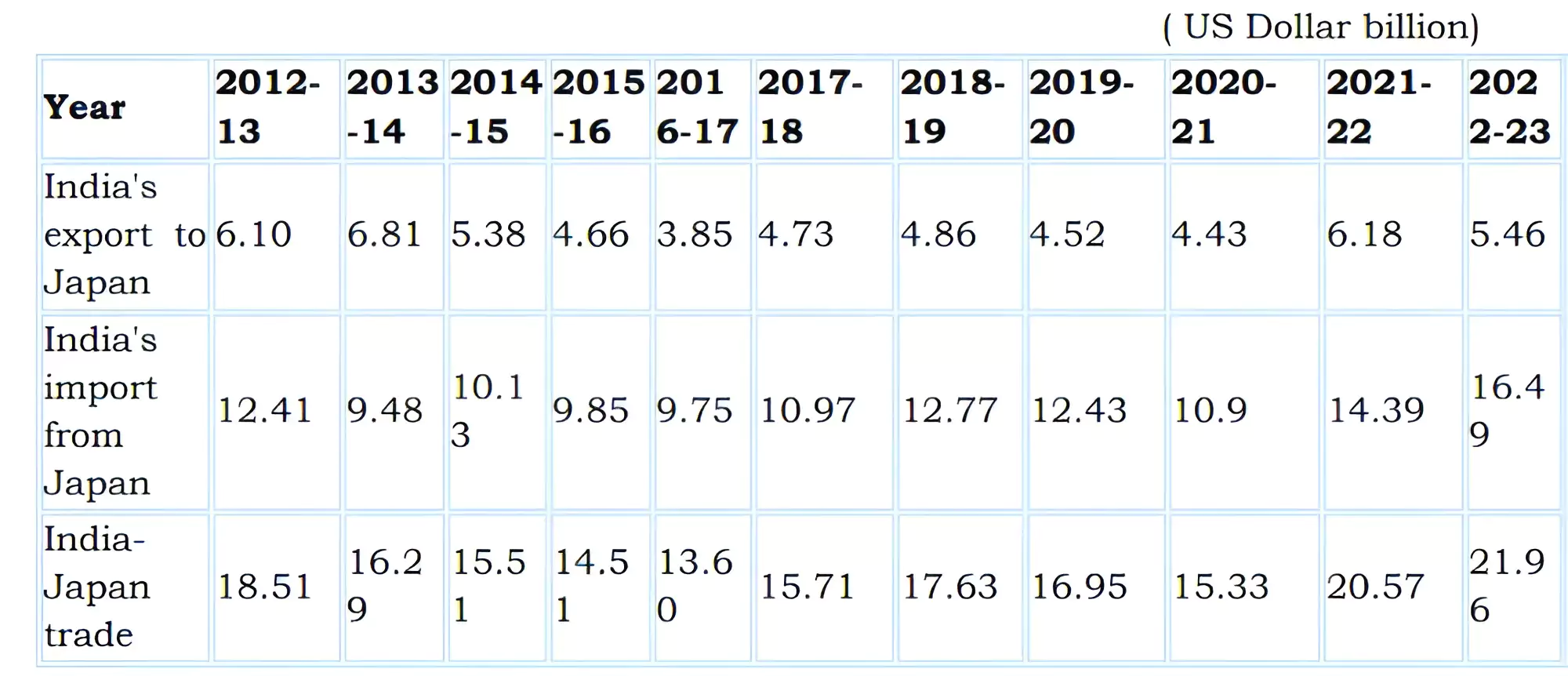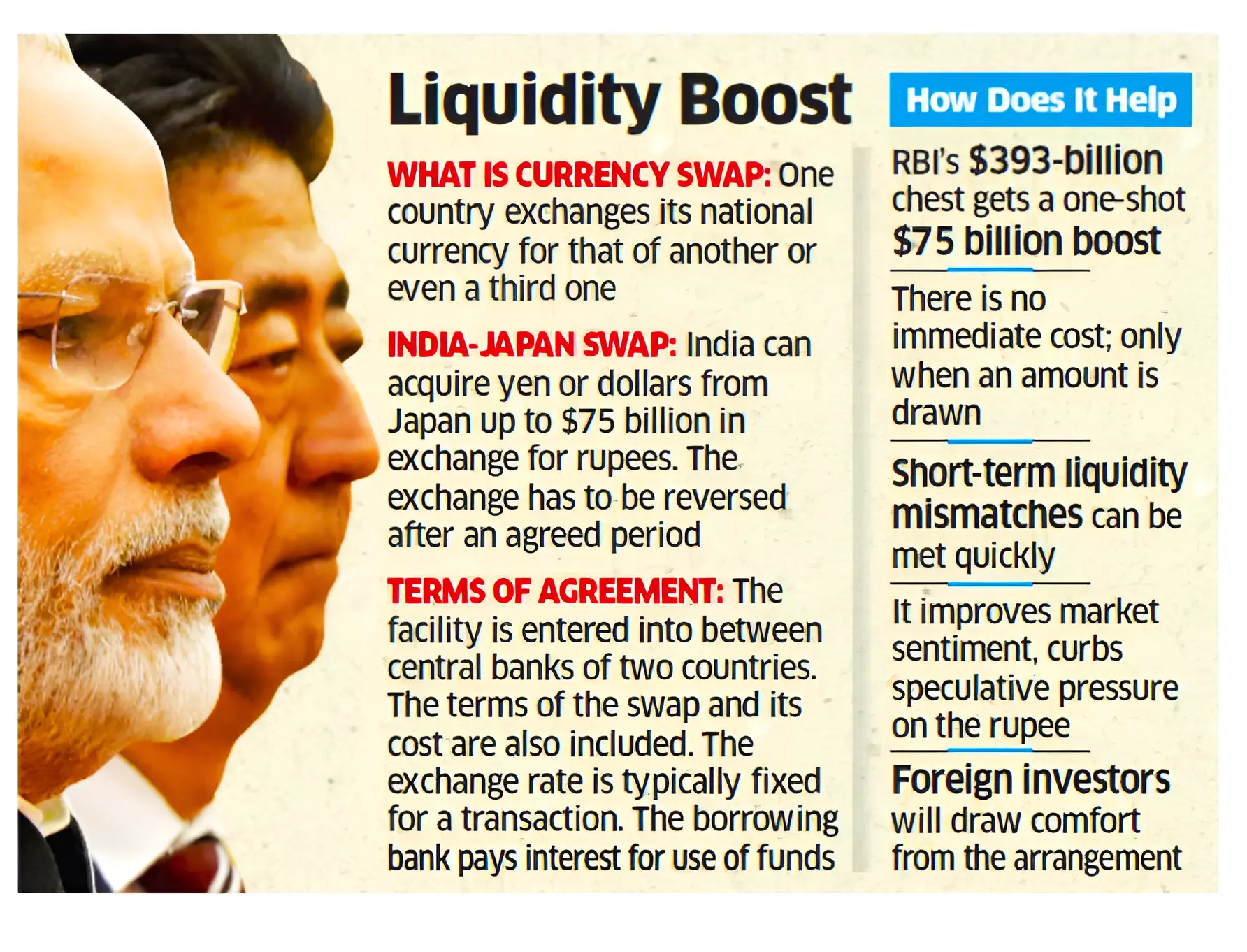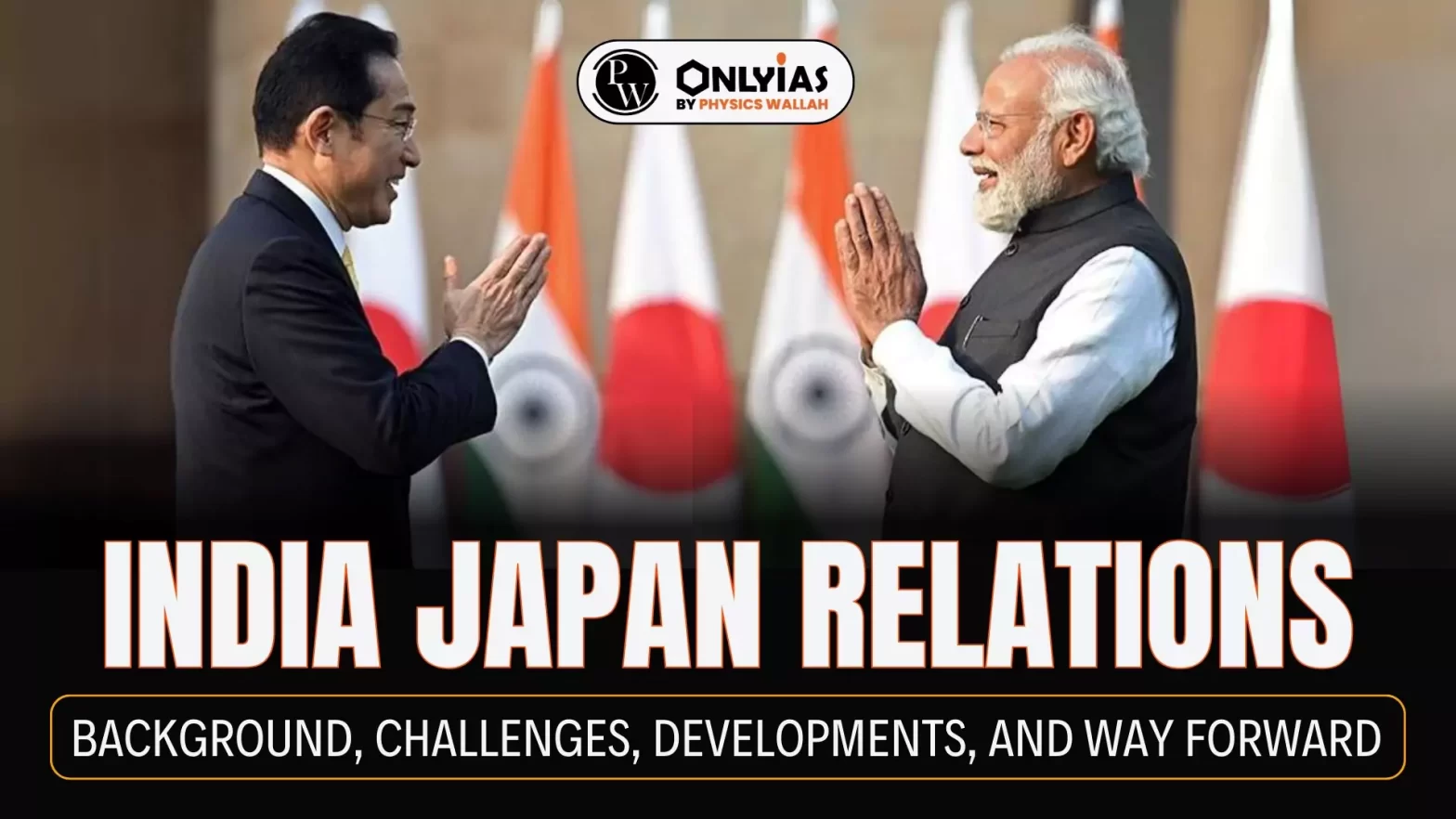Context:
This Article is based on the news “India, Japan agree to make bilateral relationship responsive to emerging geopolitical, geoeconomic, geotechnological trends” which was published in the AIR. Recently, the 16th India-Japan Foreign Minister’s Strategic Dialogue was held in Tokyo, Japan.
Key Highlights of the 16th India-Japan Foreign Minister’s Strategic Dialogue
- Development in Northeast Regions: Japan’s development role in India’s Northeast will be crucial in transforming the connectivity and industrial landscape of the region and benefit other countries in the neighbourhood through a network of forward and backward linkages.
- Economic Stability & Supply Chain Resilience: There is a need to work together to enhance each other’s economic stability and supply chain resilience by taking a strategic view of trade and technology.
- Responsive & Strategic India Japan Relations: Both sides agreed on the need for new steps to prepare the bilateral relationship for and respond to emerging geopolitical, geoeconomic and technological trends.
- To realise the vision of the India-Japan Special Strategic Global Partnership.
- Others: Both discussed possibilities in the semiconductor ecosystem, green technologies and digital payments, a more facilitative visa regime, and the provision of more excellent avenues of mobility for Indian talent and skills to Japan.
India Japan Relations: Background
Different Phases of India Japan Relations:
- Cultural & Civilization Ties: Friendship between the two countries has a long history of spiritual affinity and strong cultural and civilisational ties.
- Buddhism: The people of India and Japan have engaged in cultural exchanges, primarily due to Buddhism, which spread indirectly from India to Japan.
- Spiritual Connection: The Shichifukujin or the seven lucky gods of Japan have their roots in Hindu traditions.
- Todaiji Temple: The Todaiji Temple in Nara, Japan is where the consecration or eye-opening of the towering statue of Lord Buddha was performed by an Indian monk, Bodhisena in 752 AD.
- Post Second World War: India did not attend the San Francisco Conference but decided to conclude a separate peace treaty with Japan in 1952 after its sovereignty was fully restored, marking a defining moment in the bilateral relations and setting the tone for the future.
- The Treaty of San Francisco: It was signed by 49 nations on 8 September 1951, in San Francisco, California to re-establish peaceful relations between Japan and the Allied Powers.
- During the Cold War: India Japan Relations were constrained, Japan as a result of World War II reconstruction, was a U.S. ally, whereas India pursued a non-aligned foreign policy, often leaning towards the Soviet Union.
- Pokhran Nuclear Test: In 1998, Japan imposed sanctions on India following the Pokhran-II, an Indian nuclear weapons test.
- These sanctions were lifted three years later.
-
India Japan Relations: Diplomatic & Strategic Ties
- Peace Treaty: It began with the conclusion of a separate Peace Treaty with Japan on 28 April 1952. Since then, the India Japan relations have matured over the years to cover a wide range of areas of cooperation.
- Strengthening India Japan Relations: India Japan Relations were elevated to ‘Global Partnership’ in 2000, ‘Strategic and Global Partnership’ in 2006, and ‘Special Strategic and Global Partnership’ in 2014.
- Acquisition and Cross-Servicing Agreement (ACSA): Negotiations are going on for the agreement through which Japan could gain access to Indian facilities in the Andaman and Nicobar Islands, and India could have access to Japan’s naval facility in Djibouti.
- Civil Nuclear Cooperation: In November 2016, an agreement on Cooperation in the Peaceful Uses of Nuclear Energy was signed.
- Progress in Maritime Domain Awareness (MDA): India has two centres – Information Management and Analysis Centre (IMAC) and Information Fusion Centre – Indian Ocean Region (IFC-IOR) located at Gurugram specifically for this purpose under the National Maritime Domain Awareness (NMDA).
- Regular annual summits have been held between India and Japan since 2006.
- India-Japan Act East Forum: It was established in 2017 to provide a platform for India-Japan collaboration under India’s “Act East Policy“ and Japan’s “Free and Open Indo-Pacific Strategy”.
-
India Japan Political Relations:
- 2007: The Japanese PM Shinzo Abe visited India and delivered the famous “The Confluence of Two Seas” speech in the Indian parliament.
- He was conferred with Padma Vibhushan, India’s second-highest civilian honour in 2021.
- 2013: 2013 was a monumental year that saw the first-ever visit of the Japanese Emperor Akihito and Empress Michiko to India.
- 2019: The Indian President Ram Nath Kovind visited Japan in October 2019 to attend the Enthronement Ceremony of the Emperor of Japan.
- 2022: In March 2022, the Japanese PM officially visited India to hold the 14th India-Japan Annual Summit. Both sides agreed on a joint statement titled, “Partnership for a Peaceful, Stable and Prosperous Post-COVID World”.
- 2023: In March 2023, the Japanese PM visited India and held a bilateral meeting with the Indian PM. Both sides renewed the Memorandum of Cooperation (MoC) on Japanese Language originally signed in 2017, focusing on higher-level language learning.
- India and Japan also announced 2023 as the “India-Japan Year of Tourism Exchange” with the theme “Connecting Himalayas with Mount Fuji”.
- In May 2023, the Indian PM visited Japan to attend the G7 Summit as an invitee.
- In September 2023, the Japanese PM visited India for the G20 Summit.
- 2+2 Ministerial Meeting: It is seen as an upgrade of the meeting between foreign and defense secretaries of the two countries.
- Japan is the 2nd country with which India has 2+2 ministerial dialogue (after the USA).
- India-Japan Forum: The inaugural India-Japan Forum was held on 20 July 2021. It sees the participation of eminent representatives of both governments, Parliament, industry, think tanks and academia.
- Oldest International Friendship Body in Japan: The Japan-India Association set up in 1903 is Japan’s oldest international friendship body.
-
India Japan Defence Relations:
-
Common Groupings:
- Both India and Japan are members of Quad, G20 and G-4, International Thermonuclear Experimental Reactor (ITER).
- Japan has also joined India-led initiatives such as the International Solar Alliance (ISA), Coalition for Disaster Resilient Infrastructure (CDRI) and Leadership Group for Industry Transition (LeadIT).

-
Economic & Commercial Relations:
- Japan’s bilateral trade with India totaled US$ 21.96 billion during FY 2022-23.
- India-Japan Comprehensive Economic Partnership (CEPA): It came into effect in August 2011.
- It is the most comprehensive and covers trade in goods and services, movement of natural persons, investments, intellectual property rights, customs procedures and other trade-related issues.
- India’s Primary Exports to Japan: Petroleum products, organic chemicals; fish and crustaceans, molluscs and other aquatic invertebrates; nuclear reactors, boilers, machinery and mechanical appliances, etc.
- India’s Primary Imports from Japan: Machinery, electrical machinery, iron and steel products, plastic materials, non-ferrous metals, parts of motor vehicles etc.
- Bilateral Swap Arrangement: Both countries have agreed to a Bilateral Swap Arrangement that would allow their central banks to exchange local currencies for up to $75 billion.
 Japanese Investment and Official Development Assistance (ODA):
Japanese Investment and Official Development Assistance (ODA):
- Japanese FDI into India: It has mainly been in automobile, electrical equipment, telecommunications, chemical, financial (insurance) and pharmaceutical sectors.
- Japan is fifth among source countries for FDI after Mauritius, Singapore, the US and Netherlands.
- Japan has extended bilateral loans and grant assistance to India since 1958. Japan is the largest bilateral donor to India.
-
People-People Ties:
-
- In recent years, there has been a change in the composition of the Indian community with the arrival of many professionals, including IT professionals and engineers. The Nishikasai area in Tokyo is emerging as a “mini-India”.
Other Significant Cooperation Between India and Japan
-
India Japan Digital Partnership (IJDP) and Start-Up Hub:
- IJDP: In view of synergies and complementarities between the two nations IJDP was launched in 2018, furthering existing areas of cooperation as well as new initiatives within the scope of cooperation in S&T/ICT, focusing more on “Digital ICT Technologies”.
- Start-up Hub: Startup-India (under Invest India) and Japan Innovation Network (JIN) signed an MoU on innovation collaboration focusing on sustainable development goals connecting two start-up ecosystems in June 2018.
-
Sister-State and Sister-City Cooperation:
- There are growing links between Japanese prefectures/cities and Indian states/cities. Currently, 7 states and 4 cities/regions from India have partnered with prefectures/cities of Japan.
-
Education:
- The 1st Japan-India Universities Forum meeting was held in January 2023, the India- Japan Edu-Connect was launched in September 2023.
-
Space Cooperation between India and Japan:
- ISRO and JAXA collaborate actively in X-ray astronomy, satellite navigation, lunar exploration and the Asia Pacific Regional Space Agency Forum (APRSAF).
-
Railway Cooperation between India and Japan:
- Mumbai-Ahmedabad High-Speed Rail (MAHSR) Project: The first High-Speed Rail corridor is being implemented from Mumbai to Ahmedabad with technical and financial assistance from Japan.
- Metro Rail Projects: Presently, six Metro Rail projects (Ahmedabad, Bangalore, Chennai, Delhi, Kolkata, Mumbai) are being implemented with technical and financial support from Japan.
-
Healthcare Cooperation between India and Japan:
- India’s AYUSHMAN Bharat Programme and Japan’s AHWIN are cooperating in healthcare logistics, ICT for tertiary healthcare, and human resource development.
- The AYUSH Information Cell was launched in 2023 in the Embassy of India, Tokyo.
-
Skill Development:
-
- Under the India-Japan MoC signed in 2016, Japanese companies have established 35 Japan-India Institute of Manufacturing (JIM) in India and 11 Japanese Endowed Courses (JEC) in Indian Engineering Colleges.
-
On Clean Energy:
- India-Japan Energy Dialogue: It was set up in December 2006 to promote cooperation in the energy sector comprehensively.
- India-Japan Clean Energy Partnership (CEP): It was launched in March 2022 for cooperation in areas such as electric vehicles, storage systems including batteries, development of solar energy, etc.
-
Cool Express Mail Service (EMS):
- It was started, under which Japanese food items are transported in cool boxes from Japan to India through postal channels.
- The Department of Posts under the Ministry of Communications has launched the Cool EMS Service between India and Japan, which came into force in March 2018.
Challenges to the India Japan Relations
-
Growing Chinese Aggressiveness in the Indo-Pacific:
- China’s power and influence are growing in parts of the Indo-Pacific.
- Numerous challenges facing the Indo-Pacific such as the Ukraine war, food security, and cyber space in addition to issues such as ensuring the freedom of the seas, and connectivity among others.
- The future balance of power in the Indo–Pacific region will largely depend on the actions of the United States, China, and major powers such as Japan and India.
-
Trade Difference:
- The trade ties have remained underdeveloped compared to India’s trade ties with China.
- Both India and Japan have diverging interests concerning economic issues like E-commerce rules (Osaka track) and Regional Comprehensive Economic Partnership.
- India is struggling to penetrate the Japanese market due to language barriers, high quality and service standards.
-
China Factor:
-
- Both countries have border issues with China. So, their policy stance hinges generally on China, rather than growing comprehensively.
- India has been more vocal in criticizing China’s actions, while Japan has been more cautious in its approach.
-
Russia Factor:
- There is a difference of opinion between India and Japan on the responses to Russia’s invasion of Ukraine. Japan is part of the U.S.’s alliance and has also joined sanctions against Russia, while India has refused to do so.
- Also, there exists a difference of opinion when India participated in the Vostok Exercises, which were held close to South Kuril Island (a disputed territory between Russia and Japan).
-
Balancing between QUAD and BRICS:
- India has not joined the China-led Belt and Road Initiative (BRI), while a member of Quad & AIIB. India has long adopted a non-aligned approach as opposed to the stauncher, pro-US foreign policy stances of Japan and Australia.
- So India has to do a balancing act between Quad and BRICS.
-
Asia-Africa Growth Corridor (AAGC) Project:
- There is a scepticism on the feasibility of the AAGC itself as well as the nature of the projects embedded in it.
-
Defence Exports:
- India is looking to export defence equipment to other countries, which could potentially compete with Japan’s own defence exports.
- Negotiations to purchase amphibious US-2 planes have dragged on for years.
Way Forward to Strengthening India Japan Relations
-
Enhancement in Regional Strength:
- Both India and Japan have economic and military strength that could be used for future regional strength and counter the China factor too.
-
To Combat Pollution:
- Pollution is a serious issue, and pollution can be tackled using Japanese green technologies.
- Example– Miyawaki Technique: To create dense forests with native plants.
- Joint crediting mechanism (JCM)- Under JCM, Japanese companies, using their state-of-the-art environmental technologies, will be able to earn carbon credits in return for helping developing countries reduce greenhouse gas emissions.
-
Address the Trade Bottleneck:
- To enhance bilateral trade and realise the full potential of economic cooperation.
- Joint ventures could be created by merging Japanese digital technology with Indian raw materials and labour.
- India’s purchase of Japan’s indigenously made amphibious US-2 planes, if successfully executed, could also contribute to India’s ‘Make in India’.
-
Increase People-to-People Exchange:
- By involving Indian IT professionals in Japan to boost digitalization in Japan.
-
Expand Partnerships in Science and Technology:
- Such as 5G, Telecom Network Security, submarine cable systems, and Quantum Communications.
- Both countries are also engaged in technology in producing submarines and in cooperative research in areas like unmanned Ground Vehicle and Robotics.
-
Collaboration on Strategic Connectivity:
-
- By linking South Asia to Southeast Asia by harnessing the synergy between the “Act East” policy and the “Partnership for Quality Infrastructure”.
Conclusion
India is significantly deepening its ties with Southeast Asian countries. India should consider taking its third-country developmental model with Japan into the sub-region of the greater Indo-Pacific at a time when resident countries are looking for alternative sources of development and security amidst the polarising dynamics of the U.S.-China power competition.
Also Read: Red Sea Crisis
| Prelims PYQ (2019):
Recently, India signed a deal known as ‘Action Plan for Prioritization and Implementation of Cooperation Areas in the Nuclear Field’ with which of the following countries?
(a) Japan
(b) Russia
(c) The United Kingdom
(d) The United States of America
Ans: (b) |


 Japanese Investment and Official Development Assistance (ODA):
Japanese Investment and Official Development Assistance (ODA):
